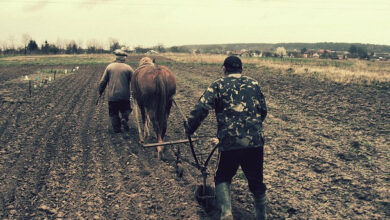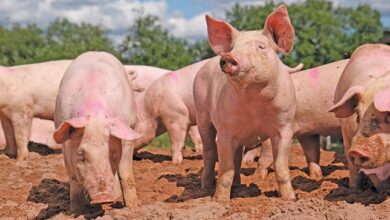A Legacy Lasting Generations: Our Family Farm Story

Every journey has its first step. Every farm has a beginning.
The stories farmers have are endless, and endlessly fascinating. Every family has endured tremendous hardship at different periods of their lives on the farm, while also experiencing wonderful success at other times. So many farms have been sold off over the decades, with larger and larger operations buying or renting them to add new family members.
That doesn’t make them failures. It’s just the story of farming, as it has always been. My farm’s story is like so many others, yet unique. Perhaps parts of it will remind you of your own, or it might inspire you to ask your parents or grandparents to tell you theirs – before it’s too late, and the stories are lost to time.
Every Journey Has A First Step
My paternal grandfather, Hubert Donald (Don) Leguee (born in 1922), was raised in Ogema, Saskatchewan, on a farm. As my Dad tells it, Don’s father hated farming. His skills were cooking and music – he would ride his horse 12 miles to play fiddle or guitar at a dance. He was a cook on a barge on the Great Lakes. Those were his true passions. But, he came to Saskatchewan, got a local girl pregnant, and had to have a quick wedding.
It wasn’t a particularly easy time, either, especially when Grandpa Don was young – growing up in the 30’s, he and his three siblings knew hunger. He remembered seeing food arrive on the trains. He was so poor as a child, he didn’t even have shoes. He saved all his money to afford winter boots. Dad says Grandpa could walk through thistle patches barefoot, so tough were his feet.
Grandma came from a far wealthier family. Her dad was a conductor for Canada Pacific Railway for 42 years. They lived in a nice house in Moose Jaw.
In 1952, after serving as a signalman in World War II, he married Elsie, and the two moved into a couple of wooden granaries nailed together. As you’d expect, the roof constantly leaked, and the leak was in a perfect spot to be extra miserable – right above their bed. It was a far cry from her family home in Moose Jaw, but she was far too stubborn to let that stop her.
The Big Move
Our entire family legacy changed in 1956, when Don, Elsie, and two of their soon to be four children moved from Ogema to our farm of today, between the village of Fillmore and the city of Weyburn, closest to a hamlet called Talmage. They had to borrow money from Grandpa’s brother-in-law to buy it. He had some money – the Veteran’s Land Act helped him buy his first 3 quarters in Ogema, that he sold before they left, but without the generosity of his family, they never would have been able to afford it. Soon after their arrival, Talmage school closed its doors, and their kids went to Fillmore school instead.

The farm my grandparents started consisted of a section of land (640 acres), cows, chickens, pigs, dairy cows, and horses. They did it all: Dad and his older sisters milked cows, fed the animals, worked the land, and maintained the machinery (especially Dad).
A Generational Transition
When Dad finished school, including welding and mechanics in Moose Jaw, he took over management of the farm. Grandpa was very ready to pass on responsibilities to Dad – perhaps too ready, in fact. When Mom and Dad got married in 1983, they moved into the farmhouse, and my grandparents built a new house just a kilometre down the road.
Unfortunately (especially for Mom), their new house wasn’t quite finished when Mom and Dad moved in, so they all lived together for a few months. Grandpa liked to sit at the kitchen table in his underwear in the mornings, waiting to hear the plan for the day from Dad. I’m sure you can imagine what Mom thought of that.
The beginning of Mom and Dad’s career in farming, the 1980’s, were incredibly difficult. In 1977, when Dad was 17, he tried to buy some land, but he was too young to borrow the money, so Grandpa bought it instead. He tried to use Farm Credit Canada to buy it, but months later, after the purchase was complete, FCC denied it, claiming that Grandpa actually had too many assets – FCC was only for starting and struggling farmers. The only way to pay for it was to get an operating line from RBC, which came with an interest rate unimaginable today: 22.5%.
They worked hard to pay it down as quickly as they could. There was a silver lining, however: Dad, newly farming, was wanting to aggressively expand, like so many of his neighbours. This setback substantially slowed their plans – which might just have saved them from buying too much and going broke like so many of their neighbours. Many of Dad’s friends’ families went broke in the early 1980’s. Drought, high interest rates, weak commodity prices, and collapsing land values sank many a successful farm. But they made it through that horrible decade, and the 1990’s were better.
The Winds of Change
By then, a new farming practice called no-till was stirring up interest all across Western Canada. Cultivators were being parked in the trees, harrow-packer bars were being sold off, and disker air seeders were being traded off on minimum-disturbance air drills.
Like most of his generation, Grandpa was not particularly excited about the change. But it was coming regardless. In April of 1992, Grandpa and Grandma headed to the cabin for a couple of weeks before seeding. When they got home, Grandpa noticed the diskers were gone… and a Concorde air seeder was sitting in its place. Dad had made the trade while Grandpa was gone! While Grandpa was very skeptical of the change, Dad was confident it would work. And it did – that was the beginning of no-till on this farm, that we continue to practice to this day.

Dad grew the farm substantially over the next couple of decades, taking it from 1,200 acres in 1990 to 9,500 acres in 2009. He went from a few dozen cows to 200, then all the way down to almost zero in that time as well. He initiated new farming practices like zero-till and continuous cropping. He invested in larger and larger machinery as crop yields grew. And he created the opportunity for me, and my siblings, to farm, encouraging us to bring home new ideas to try, just like he did.
Why am I sharing all this?
Because this story isn’t unique. This story has been repeated, each in its own unique way, across the world, over countless generations. This is the story of farming.
Last summer, we said goodbye to my Grandma Elsie just a few days short of her 94th birthday. She was a tough, strong, stubborn woman who above all else loved her family. She told me all these stories, and countless more, many times over my life. She taught me the value of grit and determination. She also taught me the importance of family, of spending time together. I will always miss the weekend 5 o’clock rye at her place. She was a special woman.

A History of Progress
Agriculture is a story of progress, of change. Too often, people outside of agriculture see it as a place of stagnation. The truth is, it’s a place of innovation.
The dream of most farmers is to pass on their farm to their children. Few actually make it. There are a thousand reasons why farms don’t make it to the next generation, from multi-year droughts, to family communication breakdowns, to something as simple as none of the kids having an interest in returning. Farming is not an easy business to make a living at, and even harder to transition.
The only way a farm can survive this generational turnover is through innovation – a farm that flatlines is a farm that fades. There are always newer, better practices, that generate greater revenue, cut expenses, or both.
One of the most important resources is the soil. How farmers care for their soil directly impacts their ability to survive across generations. Excessive tillage in the past caused the loss of up to 50% of the soil’s natural organic matter. Actions have consequences. In those days, there weren’t any alternatives to tillage. Today, at least in this area, there are.
By far, though, the most important resource on any farm is its people. Nothing gets done, no soil gets cared for, if there aren’t farmers there to do it. This is where so many farms fail. This is where we place our greatest focus.
The result of getting this right will be a farm that transitions to generation four – my children, and my nieces and nephews. The legacy my grandparents left us is to carry on this farm, with the values they worked to instill in all of us. I hope someday to do the same. I bet you do, too.





